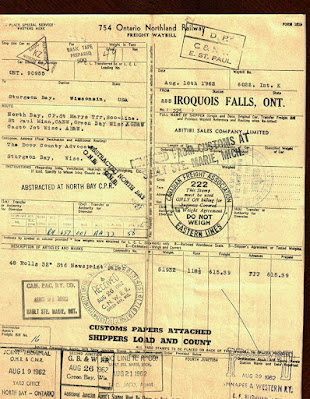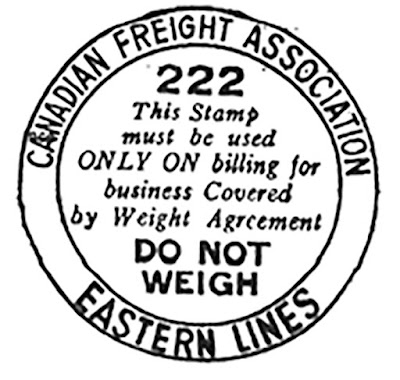I have in a number of posts described my efforts to add rubber stamps, or the images of stamps, to my model waybills. This is for the simple reason that rubber stamps of various kinds appear on most prototype waybills. To illustrate, I will show just one, from the collection of Andy Laurent, a bill for a load of newsprint paper originating in Ontario on the Ontario Northland Railway in Canada.
The stamp of interest for the present post is the large round one about mid-height in this image, just to the right of center. It’s a weight agreement stamp, for the Canadian Freight Association, Eastern Lines. There are other interesting features on this waybill, including the customs clearance and the notation, “customs papers attached,” but I will focus on the weight agreement stamp.
In my previous posts (beginning with: https://modelingthesp.blogspot.com/2020/10/waybills-part-73-creating-rubber-stamps.html ) I have described the process of creating the stamp images, so won’t go into detail. Basically, the scan such as the one above can be cleaned up in Photoshop and all background parts of the form removed, and an image of just the stamp can be achieved. Here is the stamp image that results from the Ontario Northland waybill:
Once a clean image of the stamp is accomplished, I use the “layers” feature of Photoshop to add a transparent layer below the layer with the stamp image. Then I select all the white parts of the stamp image and delete them, leaving just the black parts on a transparent background. This allows the stamp tiff to be placed onto a waybill and only the black parts are added.
To illustrate how this is used, I show below a waybill from my layout for an arriving loaded car that originated in the eastern part of Canada and has cleared customs. Whether the routing shown via Huntington, British Columbia is realistic, I don’t know; perhaps a reader can correct me.
I should mention that there was also a “Western Lines” stamp for the Canadian Freight Association, which I showed in an earlier post about weight agreement stamps (see it at: https://modelingthesp.blogspot.com/2021/02/waybills-part-79-weight-stamps.html ). Its format is fairly different from this Eastern Lines one.
Though I have not seen an explicit description of how Canada was divided into Eastern Lines and Western Lines, I infer from a map of national freight bureau territories that I included in a previous post (find it at this link: https://modelingthesp.blogspot.com/2021/05/waybillls-part-85-more-on-weight.html ), that the divider was the 90th meridian, in western Ontario, at the western tip of Lake Superior. If anyone can correct that interpretation, please do so.
I showed in an earlier post the creation of a customs stamp like the one shown in this model waybill. I have noticed in Andy Laurent’s waybill collection that a variety of such stamps can be seen, suggesting there was not a standard stamp of this kind. In fact, the customs stamp on the Ontario Northland waybill above is an example; it reads, “RELEASED FROM CUSTOMS AT SAULT STE. MARIE, MICH.” I will likely make some more customs stamps to give variety to my own waybills. (You can see my first post on customs stamps at: https://modelingthesp.blogspot.com/2020/10/waybills-part-74-more-stamps.html .)
Tony Thompson



No comments:
Post a Comment